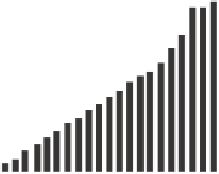Agriculture Reference
In-Depth Information
FIRE
50
40
30
20
2
2
2
3
9
2
6
5
8
6
15
10
11
17
25
2
4
2
9
19
10
15
5
9
10
17
28
26
Ceanothus spinosus
Heteromeles arbutifolia
Fig. 3.4
Distribution of stem ages on two individual resprouting shrubs: the facultative seeder
Ceanothus spinosus
and the obligate resprouter
Heteromeles arbutifolia
, both from California
chaparral. Bar indicates stem age and each bar represents one stem, unless topped with a
number; hatched bars indicate dead stems. (From Keeley
1992c
.)
carbohydrates is variable (Bond & Midgley
2003
; Cruz
et al.
2003b
). Other
seasonal effects include tissue hydration since hydrated cells are less tolerant of
high temperatures (Whelan
1995
).
There are age effects on resprouting capacity. For example, some arboreal oaks
(
Quercus
spp.) resprout from the base as young saplings but at maturity lack this
resprouting capacity (Longhurst
1956
). This is consistent with the wider distribution
of basal resprouting, which is common in crown fire regimes but less common in surface
fire regimes. In essence oak saplings experience crown fires and thus resprouting capacity
has substantial selective value, but as they mature they are exposed to surface fires, and
this has not selected for basal resprouting at this stage. Thus, in the rare event fires are
carried into the canopy these mature trees generally do not resprout from the base. This
may be the selective basis for the widespread distribution of this age effect on resprouting
in North American trees (Del Tredici
2001
) and may also explain a very similar age-
related change in resprouting in tropical savanna trees (Bond & Midgley
2003
).
Age effects are also evident in other growth forms. California subshrubs
resprout vigorously at a young age but later lose the resprouting capacity
(Hobbs & Mooney
1985
; Keeley
2006c
). It has been hypothesized that this is
due to phylogenetic constraints because the genera that exhibit this pattern are
from herbaceous perennial lineages (e.g.
Artemisia
,
Eriogonum
) and these sub-
shrubs have lost the resprouting capacity due to secondarily evolved lignification
that buries adventitious buds in older stems (Keeley
2006c
).
One complication in understanding the origins of postfire resprouting is that
sprouting is a feature of canopy rejuvenation (
Fig. 3.4
) that often occurs in the



























